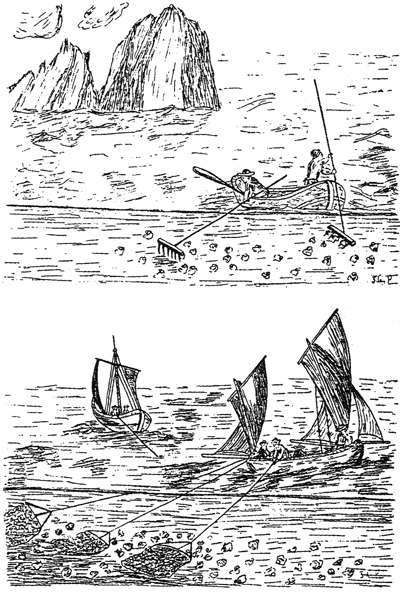Hear some of the resilient folks in the oyster-aquaculture biz on the Maine Coast
Oysters growing in baskets.
— Photo by Saoysters
Listen to these podcasts with the plucky and ingenious oyster farmers on the Pine Tree State’s storied coast. Just hit this link.
Study says oyster aquaculture is good for wild oysters too
From ecoRI News (ecori.org)
KINGSTON, R.I.
A fisheries researcher at the University of Rhode Island has found that oyster aquaculture operations can limit the spread of disease among wild populations. The findings are contrary to long-held beliefs that diseases are often spread from farmed populations to wild populations.
“The very act of aquaculture has positive effects on wild populations of oysters,” said Tal Ben-Horin, a postdoctoral fellow at the URI Department of Fisheries, Animal and Veterinary Sciences. “The established way of thinking is that disease spreads from aquaculture, but in fact aquaculture may limit disease in nearby wild populations.”
Working with colleagues at the University of Maryland Baltimore County, Rutgers University, the U.S. Department of Agriculture, and the Virginia Institute of Marine Science, Ben-Horin integrated data from previous studies into mathematical models to examine the interactions between farmed oysters, wild oysters, and the common oyster disease Dermo.
Their research, part of a synthesis project at the National Center for Ecological Analysis and Synthesis, was recently published in the journal Aquaculture Environment Interactions.
According to Ben-Horin, diseases are among the primary limiting factors in wild oyster populations. There are few wild populations of oysters in New England because of Dermo and other diseases, and in the Chesapeake Bay and Delaware Bay, wild oysters are managed with the understanding that most will die from disease.
Dermo is caused by a single-celled parasite that occurs naturally in the environment and proliferates in the tissue of host oysters, which spread the parasite to other oysters when they die and their parasite-infected tissues decay in the water column. But it takes two to three years for the parasite to kill the oysters. As long as the oysters are held on farms long enough to filter disease-causing parasites from the water, but not so long that parasites develop and proliferate and spread to wild oysters nearby, aquaculture operations can reduce disease in wild populations.
The disease doesn’t cause illness in humans.
“As long as aquaculture farmers harvest their product before the disease peaks, then they have a positive effect on wild populations,” Ben-Horin said. “But if they’re left in the water too long, the positive effect turns negative.”
He said that several factors can confound the positive effect of oyster aquaculture. Oyster farms that grow their product on the bottom instead of in raised cages or bags, for instance, are unlikely to recover all of their oysters, resulting in some oysters remaining on the bottom longer. This would increase rather than reduce the spread of the disease.
“But when it’s done right, aquaculture can be a good thing for wild oyster populations,” Ben-Horin said. “Intensive oyster aquaculture, where oysters are grown in cages and growers can account for their product and remove it on schedule, is not a bad thing for wild populations.”
The study’s findings have several implications for the management of wild and farmed oysters. Ben-Horin recommends establishing best management practices for the amount of time oysters remain on farms before harvest. He also suggests that aquaculture managers consider the type of gear — whether farmers hold oysters in cages and bags or directly on the seabed — when siting new oyster aquaculture operations near wild oyster populations.
The next step in Ben-Horin’s research is to gain a better understanding of how far the Dermo parasite can spread by linking disease models with ocean circulation models.
“Everything that happens in the water is connected,” he said. “There’s a close relationship between the wild and farmed oyster populations and their shared parasites. Sometimes ecosystem level effects are overlooked, but in this case they’re front and center.”
Study co-author Ryan Carnegie, of the Virginia Institute of Marine Science, said this research is an important contribution to the dialogue about the interactions between shellfish aquaculture and the environment.
“It’s critical that we fully appreciate how aquaculture fits in the ecology of marine systems, and this study provides new perspective on this,” he said. “It highlights an important ecological benefit that intensive shellfish aquaculture may provide. This should help bolster the well-justified public perception of shellfish aquaculture as a green industry worthy of their support, which this industry must have if it is to grow.”



